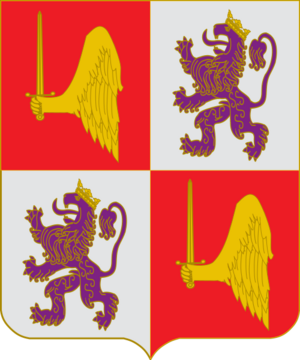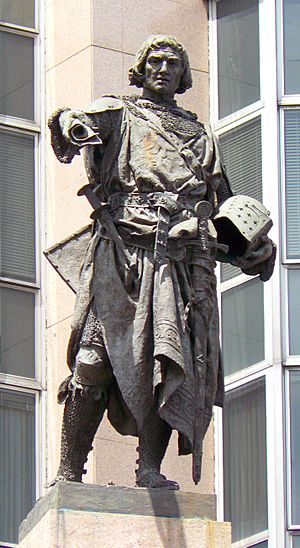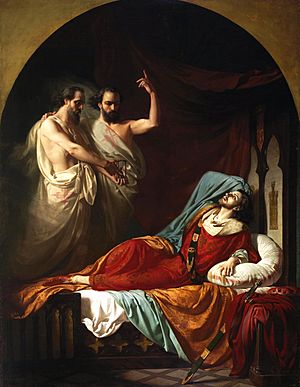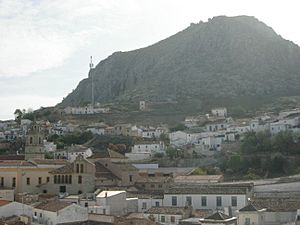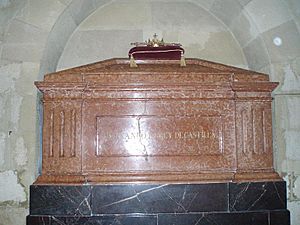Ferdinand IV of Castile facts for kids
Quick facts for kids Ferdinand IV |
|
|---|---|

Ferdinand IV in a miniature of the Compendio de crónicas de reyes, currently displayed in the Biblioteca Nacional de España.
|
|
| King of Castile and León | |
| Reign | 25 April 1295 – 7 September 1312 |
| Predecessor | Sancho IV |
| Successor | Alfonso XI |
| Born | 6 December 1285 Seville |
| Died | 7 September 1312 (aged 26) Jaén |
| Burial | Royal Collegiate Church of Saint Hippolytus |
| Spouse | Constance of Portugal |
| Issue | Eleanor, Queen of Aragon Alfonso XI, King of Castile |
| House | Castilian House of Ivrea |
| Father | Sancho IV, King of Castile |
| Mother | María de Molina |
| Religion | Roman Catholicism |
Ferdinand IV of Castile (born December 6, 1285 – died September 7, 1312) was known as the Summoned. He ruled as King of Castile and León from 1295 until his death.
Ferdinand became king when he was very young. His mother, Queen María de Molina, took care of him. She also worked hard to keep the powerful nobles from causing trouble. She often stopped them from trying to remove Ferdinand from the throne. Some nobles, like his uncle John of Castile, Lord of Valencia de Campos, and Juan Núñez II de Lara, often rebelled against him.
Like the kings before him, Ferdinand IV continued the Reconquista. This was the effort to take back lands from Muslim rule. He captured the city of Gibraltar in 1309. In 1312, the city of Alcaudete was also conquered. During his reign, he tried to make the government stronger. He wanted to reduce the power of the nobles. He died in Jaén when he was only 26 years old. His body rests in the Royal Collegiate Church of Saint Hippolytus.
Contents
- Life of Ferdinand IV
- Early Years (1285–1295)
- Becoming King (1295–1312)
- Under His Mother's Care (1295–1301)
- The Treaty of Alcañices (1297)
- End of His Minority (1297–1301)
- Ferdinand's Personal Rule (1301–1312)
- Meeting of Ariza and Henry's Death (1303)
- Treaty of Torrellas (1304)
- Treaty of Elche (1305)
- Biscay Conflicts (1305–1307)
- Internal Conflicts and Grijota Meeting (1307–1308)
- Treaty of Alcalá de Henares (1308)
- Conquest of Gibraltar and Siege of Algeciras (1309)
- Final Years and Death (1310–1312)
- Last Period of Ferdinand IV's Life (1312)
- Burial
- Marriage and Children
- See also
Life of Ferdinand IV
Early Years (1285–1295)
Ferdinand was born in Alcazar de San Juan on December 6, 1285. He was the first son of King Sancho IV of Castile and Queen María de Molina. He was baptized in Seville Cathedral. Right away, he was named the next in line to the throne. The nobles of the kingdom honored him.
King Sancho IV chose Fernán Pérez Ponce de León to raise his son. Fernán Pérez had been a main advisor to King Alfonso X. Prince Ferdinand and his tutor went to Zamora. This was where Fernán Pérez's family lived. The King also appointed other important people to help the prince. These included chancellors and a treasurer. Fernán Pérez and his wife had a big influence on Ferdinand. He was very grateful to them when he became king.
Even as a child, there were talks about his marriage. King Sancho IV wanted him to marry a princess from France or Portugal. In 1291, an agreement was made with King Denis of Portugal. It was decided that Ferdinand would marry Constance, the Portuguese king's daughter. However, King Sancho IV later thought about marrying Ferdinand to a French princess. But Sancho IV died a year later, ending those plans.
Becoming King (1295–1312)
Under His Mother's Care (1295–1301)
King Sancho IV of Castile died in Toledo on April 25, 1295. His son Ferdinand, who was only 9 years old, became king. After the funeral, his mother, María de Molina, became the regent. This meant she would rule until Ferdinand was old enough. Their marriage had been questioned, making Ferdinand's right to the throne uncertain. So, Queen María de Molina faced many challenges to keep her son as king.
She had to deal with constant fights among the Castilian nobles. Her brother-in-law, John of Castile, Lord of Valencia de Campos, claimed the throne. Her great-uncle, Henry of Castile the Senator, wanted to be the king's guardian. Also, the "Infantes de la Cerda" (Alfonso and Ferdinand), who were grandsons of King Alfonso X, claimed the throne. They had support from France and Aragon. On top of this, Aragon, Portugal, and France tried to take advantage of Castile's problems. Many nobles, like Diego López V de Haro and Juan Núñez II de Lara, also caused chaos.
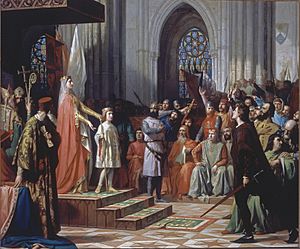
In 1295, a meeting of nobles and city representatives, called the Cortes, was held in Valladolid. Henry of Castile was chosen as the king's guardian. But Queen María de Molina, with support from the cities, made sure she kept custody of her son. During this time, John of Castile tried to take over cities. He also went to Portugal to convince King Denis to declare war on Castile.
In the summer of 1295, Queen María and Henry of Castile met with King Denis of Portugal. They gave him some towns near the Portuguese border. They also confirmed that Ferdinand IV would marry Constance of Portugal. Ferdinand's younger sister, Beatrice, would marry Afonso, the heir to the Portuguese throne. Meanwhile, King James II of Aragon returned Ferdinand's sister, Isabella, who was supposed to marry him. James II then declared war on Castile.
In 1296, John of Castile rebelled again. He took several towns. Alfonso de la Cerda, with Aragonese troops, invaded Castile. John of Castile was proclaimed King of León, Seville, and Galicia. Alfonso de la Cerda was proclaimed King of Castile, Toledo, and other regions. They then tried to capture Valladolid, where the Queen and Ferdinand IV were. Henry of Castile went to the Emirate of Granada to make peace with the Sultan. The Sultan's troops were attacking Castilian lands.
The Queen continued to fight the rebels. Henry of Castile returned to Castile. He feared losing his role as guardian. He attacked the Granadians, but his forces were defeated. In 1297, during the Cortes of Cuellar, Henry of Castile wanted to give the city of Tarifa back to the Muslims. But Queen María de Molina stopped him. She also prevented him from giving the Castle of Alarcón to his nephew, Juan Manuel, Prince of Villena.
The Treaty of Alcañices (1297)
In 1296, Queen María de Molina warned the Portuguese king to stop attacking Castile. King Denis of Portugal agreed.
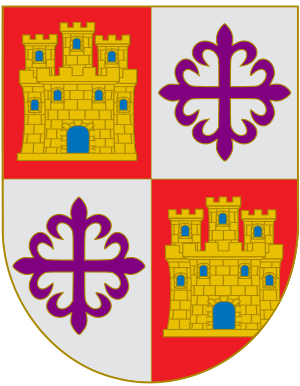
The Treaty of Alcañices was signed in 1297. It set the borders between Castile and Portugal. Portugal received several towns and fortresses. In return, Portugal broke its agreements with James II of Aragon and the rebellious nobles. The treaty also confirmed the marriages between Ferdinand IV and Constance of Portugal, and between Beatrice of Castile and Afonso of Portugal.
Portugal also sent an army to help Queen María de Molina fight John of Castile. The treaty also gave Portugal some towns as compensation for past losses. Both kingdoms agreed to respect their new borders. This treaty was very important. It helped secure Ferdinand IV's position on the throne. It also allowed Queen María de Molina more freedom to act without worrying about Portugal.
End of His Minority (1297–1301)
At the end of 1297, the Queen sent Alonso Pérez de Guzmán to León. He was to fight against John of Castile, who still controlled the area. In 1298, Alfonso de la Cerda and John of Castile started making fake coins. This was to harm the economy of Castile and León. Juan Núñez II de Lara took over some towns. Henry of Castile again suggested selling Tarifa to the Muslims, but the Queen refused.
In 1298, the Queen met with the King of Portugal. She asked for help against John of Castile. But the Portuguese king refused. He and Henry of Castile wanted Ferdinand IV to make peace with John of Castile. They suggested John keep Galicia and León for his lifetime. But the Queen disagreed. She bribed Henry of Castile to drop the idea.
After this meeting, the Queen sent her 7-year-old son, Philip, to Galicia. This was to strengthen royal power there. In 1299, the Queen recovered some castles. Juan Alfonso de Haro captured Juan Núñez II de Lara. Juan Núñez was later released. He agreed to marry his sister to Henry of Castile. He also promised to be loyal to Ferdinand IV and return some towns.
In March 1300, the Queen met King Denis of Portugal again. He needed money for the Pope to approve the marriages. In the Cortes of Valladolid in 1300, the Queen got the money. This allowed Pope Boniface VIII to declare Sancho IV's marriage to María de Molina valid. This meant Ferdinand IV was officially a legitimate king.
During the 1300 Cortes, John of Castile gave up his claim to the throne. He swore loyalty to Ferdinand IV. In return, he received several cities. The Queen and other nobles then tried to capture Almazán. But Henry of Castile stopped the siege.
In 1301, King James II of Aragon besieged Lorca. The Queen ordered her troops to help Lorca. She also besieged Murcia, where James II was. Henry and John of Castile warned James II, helping him escape. They wanted to keep good relations with Aragon.
In the Cortes of Burgos in 1301, money was approved for the war against Aragon and Granada. Money was also sent to the Pope to legitimize the Queen's marriage. This was despite a famine in the kingdom. In June 1301, in the Cortes of Zamora, John of Castile and other nobles approved more funds.
Ferdinand's Personal Rule (1301–1312)

In November 1301, Pope Boniface VIII officially declared Ferdinand IV's parents' marriage valid. This meant Ferdinand was a legitimate king. He was also declared old enough to rule on his own (legal majority) on December 6, 1301. This removed a major reason for John of Castile and the "Infantes de la Cerda" to claim the throne. The Pope also approved Ferdinand's marriage to Constance of Portugal.
Henry of Castile was unhappy about the Pope's decision. He teamed up with Juan Núñez II de Lara to turn Ferdinand against his mother. John of Castile also joined them. He still wanted the Lordship of Biscay for his wife.
In 1301, while the Queen was away, John of Castile and Juan Núñez II de Lara tried to make Ferdinand distrust his mother. They took him hunting in León, which he loved. Henry of Castile and Diego López V de Haro demanded more towns from Ferdinand. They threatened war if their demands were not met. Ferdinand gave them the towns of Atienza and San Esteban de Gormaz.
On January 23, 1302, Ferdinand IV married Constance in Valladolid. In May 1302, at the Cortes of Medina del Campo, Henry and John of Castile and Juan Núñez II de Lara tried to accuse the Queen of stealing money. But her chancellor showed that she had not. She had even used her own money to help the kingdom. While the Cortes were happening, Sultan Muhammed II al-Faqih of Granada died. His son, Muhammad III, attacked Castile and León.
In July 1302, Ferdinand IV went to the Cortes of Burgos with his mother. Their relationship was good again. Ferdinand decided not to invite John of Castile and Juan Núñez II de Lara to the Cortes. After the Cortes, Ferdinand went to Palencia for a wedding.
At this time, there was a strong rivalry between Henry of Castile, María de Molina, and Diego López V de Haro on one side. On the other side were John of Castile and Juan Núñez II de Lara. Henry of Castile threatened war if his demands were not met. The nobles wanted to reduce the Queen's influence on her son. In late 1302, the Queen had to calm the nobles. They were planning to rebel against Ferdinand IV.
In early 1303, Ferdinand IV planned to meet King Denis of Portugal. He hoped to get back some land. Henry of Castile, Diego López V de Haro, and the Queen did not attend. The Queen wanted to keep an eye on Henry of Castile and Diego López V de Haro. Their relationship with Ferdinand IV was tense. In May 1303, the meeting between Ferdinand IV and Denis of Portugal happened in Badajoz. John of Castile and Juan Núñez II de Lara made Ferdinand distrust Henry of Castile and Diego López V de Haro.
Meeting of Ariza and Henry's Death (1303)
In 1303, Henry of Castile, Diego López V de Haro, and Juan Manuel, Prince of Villena met. They planned to meet the King of Aragon. Henry's plan was to make Alfonso de la Cerda King of León. He also wanted Ferdinand's brother, Peter, to be King of Castile. This would have broken up the kingdom.
Queen María de Molina refused to support this plan. She reminded the nobles of their loyalty to her son. This made some knights leave the meeting. Henry of Castile, Juan Manuel, and others still planned to fight Ferdinand IV. They also wanted to give some land to Aragon and Alfonso de la Cerda. But Henry of Castile became very ill.
The Queen feared that Henry's lands would go to Juan Manuel. She tried to convince Henry to return his lands to the Crown. But he refused. When Juan Manuel arrived, he thought Henry was dead. He took all valuable items and left.
The Queen sent orders to Henry's fortresses. She said that if he died, they should only surrender to the King's troops. Henry of Castile died on August 8, 1303. He was buried in Valladolid. His vassals did not show much sadness. The Queen ordered a proper funeral for him.
While Henry was dying, Ferdinand IV made a deal with Sultan Muhammed III of Granada. The Sultan would keep some cities. Ferdinand IV would keep Tarifa. The Sultan also agreed to be Ferdinand's vassal and pay him tribute. When Ferdinand IV heard of Henry's death, he was pleased. He gave most of Henry's land to Juan Núñez II de Lara. He also returned Écija to his mother. In November 1303, Ferdinand asked his mother for advice. He wanted to end the dispute between John of Castile and Diego López V de Haro over the Lordship of Biscay. The Queen agreed to help.
In January 1304, John of Castile again claimed the Lordship of Biscay for his wife. Ferdinand IV offered other towns as compensation. But John of Castile refused. Ferdinand then suggested a different division of lands. John of Castile accepted. But Diego López V de Haro refused and threatened to rebel. Ferdinand then made his mother reconcile with Juan Núñez II de Lara. They began talks for the Treaty of Torrellas.
Ferdinand IV took lands from Diego López V de Haro and Juan Alfonso de Haro. He divided them among other nobles. But these nobles did not rebel. Meanwhile, in Galicia, Ferdinand's brother, Philip, defeated and killed Fernando Rodríguez de Castro.
Treaty of Torrellas (1304)
A very important event was the agreement with King James II of Aragon in 1304. This was called the Treaty of Torrellas. It aimed to settle borders and end the claims of Alfonso de la Cerda to the throne.

On August 8, 1304, the terms of the Treaty of Torrellas were made public. King Denis of Portugal, the Archbishop of Zaragoza, and John of Castile were involved. The goal was to divide the Kingdom of Murcia between Aragon and Castile. Sultan Muhammed III of Granada also took part. He wanted to keep good relations with Castile.
The treaty divided Murcia along the Segura river. Aragon received cities like Alicante and Elche. Castile received cities like Murcia and Lorca. People could choose to stay or leave their cities. Both kingdoms agreed to free war prisoners. They also promised to be enemies of each other's rivals, except the Pope and France. The Seigneury of Villena stayed with Prince Juan Manuel. But it became part of Aragon.
Alfonso de la Cerda was given several lordships and lands. This was in exchange for giving up his claim to the Castilian throne. He also promised to return some cities to the King. However, he soon used royal symbols again. His claim was finally settled later, during the reign of Ferdinand's son, Alfonso XI.
Ferdinand IV promised that nobles, church leaders, and cities would follow the treaty. In 1305, Ferdinand's cousin, Ferdinand de la Cerda, paid homage to him. He confirmed that Alfonso de la Cerda had received his lands.
In January 1305, Ferdinand IV again asked Diego López V de Haro to return the Lordship of Biscay to his niece. But he refused.
Treaty of Elche (1305)
To solve some issues from the Murcia division, Ferdinand IV and James II of Aragon met. This meeting happened on February 26, 1305. Many important people attended.
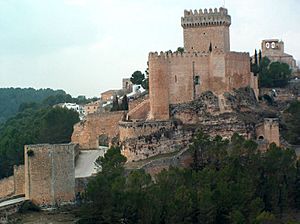
Violante Manuel, Juan Manuel's sister, gave up her lordships. In return, she received other lands from Ferdinand IV. Juan Manuel also received the Castle of Alarcón. This was in exchange for giving up Elche.
James II of Aragon refused to give the Lordship of Albarracín to Juan Núñez II de Lara. Juan Núñez blamed John of Castile for this. This caused a rift between them. Finally, the Treaty of Elche was signed on May 19, 1305. It set the final border of Murcia. The Segura river became the dividing line. Castile received Murcia, Molina de Segura, and Cartagena. The transfer of Cartagena to Castile was on condition that Ferdinand IV respected Juan Manuel's property. The town of Yecla also stayed with Juan Manuel.
This division of Murcia did not consider the region's history. The northern part went to Aragon. The southern part, including Cartagena and Murcia city, went to Castile.
Biscay Conflicts (1305–1307)
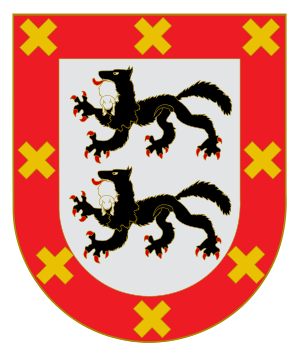
In 1305, Diego López V de Haro was called to a meeting in Medina del Campo. He was to answer claims from his niece, María I Díaz de Haro. She wanted the Lordship of Biscay. Her husband, John of Castile, supported her.
John of Castile argued that Biscay was illegally taken by Sancho IV. But Diego López V de Haro said John and his wife had given up their rights in 1300. No agreement was reached. Diego López V de Haro returned to Biscay. Ferdinand IV offered María I Díaz de Haro other cities in Biscay. But she refused, advised by Juan Núñez II de Lara. John of Castile and Diego López V de Haro signed a two-year truce.
In 1306, Lope Díaz de Haro, Diego López V de Haro's son, tried to convince his father to accept the King's offer. The King made Lope Díaz de Haro his First Majordomo. Later, Diego López V de Haro met the King. But he angered the King by bringing Juan Núñez II de Lara. Diego López V de Haro left without the King's permission.
In April 1306, John of Castile convinced Ferdinand IV to declare war on Juan Núñez II de Lara. John knew Diego López V de Haro would defend him. Juan Núñez II de Lara escaped a siege. He and Diego López V de Haro agreed to fight Ferdinand IV separately. The King's troops demanded more money. So, Ferdinand asked John of Castile to negotiate peace.
The negotiations did not start. The war continued. Ferdinand IV asked his mother to help. She arranged a meeting in Pancorbo. An agreement was made. The rebellious nobles gave castles as hostages to the King. The King promised to respect their lands and pay their troops. But John of Castile was not happy. He again claimed Biscay. Ferdinand IV, trying to please John, took the region of Galicia from his brother Philip. He gave it to John of Castile's advisor.
Ferdinand IV then sent Alonso Pérez de Guzmán and Juan Núñez II de Lara to talk with Diego López V de Haro. But he still refused to give Biscay to John of Castile and his wife. John of Castile then asked Juan Manuel for support. The King and his mother tried to convince Juan Núñez II de Lara to persuade Diego López V de Haro. In September 1306, Ferdinand IV met Diego López V de Haro. The King suggested that Diego López V de Haro keep Biscay for his lifetime. After his death, it would go to María I Díaz de Haro. But Diego López V de Haro refused. He appealed to the Pope again.
In early 1307, the King, his mother, and John of Castile learned that Pope Clement V recognized the validity of John and his wife's oath from 1300. This meant John of Castile had to accept it. In February 1307, another attempt was made to solve the Biscay dispute. The terms were similar to before. But Diego López V de Haro still refused. Soon after, a meeting of the Cortes was called in Valladolid.
In the 1307 Cortes, Queen María de Molina saw that nobles were protesting the King's advisors. To please John of Castile, she tried to end the Biscay dispute. She convinced her half-sister, Juana Alfonso de Molina, to persuade her daughter, María I Díaz de Haro, to accept the King's offer. Diego López V de Haro and his son, Lope Díaz de Haro, agreed to the terms. María I Díaz de Haro would inherit Biscay after her uncle's death. Lope Díaz de Haro would receive certain cities.
Juan Núñez II de Lara felt ignored. He left the Cortes. Ferdinand IV then made Diego López V de Haro his First Majordomo. This made John of Castile angry. He left the court. But soon after, they all met in Lerma. The Biscay nobles agreed to pay homage to María I Díaz de Haro as the future Lady of Biscay. The same oath was made for the cities Lope Díaz de Haro would receive.
Internal Conflicts and Grijota Meeting (1307–1308)
In 1307, John of Castile and Diego López V de Haro advised the King to order Juan Núñez II de Lara to leave Castile. Juan Núñez also had to return some castles. Ferdinand IV went to Palencia, where his mother advised him to be firm. Ferdinand then went to Tordehumos and surrounded the town. Many nobles and troops joined him. John of Castile and his son also arrived with their troops.
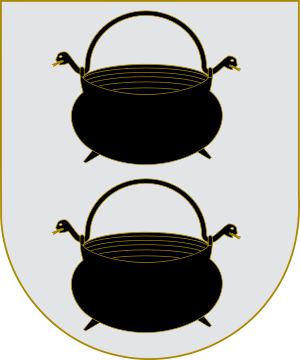
During the siege of Tordehumos, Ferdinand IV received an order from Pope Clement V. He was to seize the castles of the Knights Templar. John of Castile offered a peace proposal from the besieged, but Ferdinand refused. The King had trouble paying his troops. He sent his wife, Queen Constance, and their newborn daughter, Eleanor, to Portugal to ask for a loan. John of Castile, feeling resentful, advised the King to abandon the siege. But Ferdinand distrusted him.
Some nobles deserted, and the Queen became ill. Ferdinand IV decided to negotiate with Juan Núñez II de Lara. Tordehumos surrendered in early 1308. Juan Núñez II de Lara promised to give all his lands to the King, except those in La Bureba and La Rioja. He also paid homage to Ferdinand IV. The King made this agreement without his mother's knowledge.
After the siege, some nobles tried to turn the King against Juan Núñez II de Lara and John of Castile. They told each that Ferdinand wanted them dead. So, John of Castile and Juan Núñez II de Lara allied. But the Queen convinced them that Ferdinand meant no harm. They then asked to present their demands to the Queen, not the King. The demands were accepted. The King agreed to replace his advisors and give certain regions to other nobles.
In 1308, Rodrigo Yáñez, Master of the Knights Templar in Castile, offered to surrender the Order's fortresses to the Queen. She agreed, with the King's consent. But the Master gave them to Ferdinand's brother, Philip. He asked Philip to request that the King meet the Templars' demands.
In the Cortes of Burgos in 1308, Ferdinand IV tried to bring order to his kingdom. He wanted to balance the budget and reorganize the court. He also tried to reduce John of Castile's power, but this was impossible. John of Castile sued Philip of Castile for Templar castles. Philip was forced to give them to the King. The Master of the Templars promised to give the remaining castles to Ferdinand IV.
Treaty of Alcalá de Henares (1308)
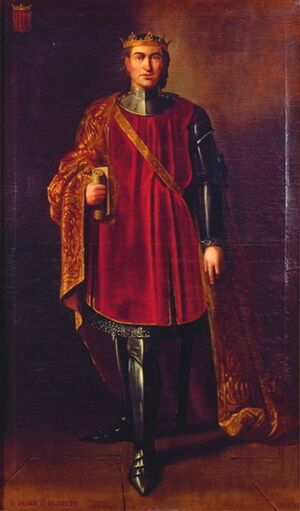
In 1306, Ferdinand IV wanted to meet with James II of Aragon. The meeting was delayed several times due to internal conflicts. The Treaty of Alcalá de Henares was signed on December 19, 1308. It aimed to restart the Reconquista wars. It also arranged the marriage of Ferdinand's daughter, Eleanor, to James of Aragon, James II's son. Finally, it settled the commitments made with Alfonso de la Cerda.
Eleanor of Castile married James of Aragon in 1319. But James later left the marriage and became a monk. Eleanor later remarried James II's second son, Alfonso IV. Ferdinand IV gave Alfonso de la Cerda more money and lands. In return, Alfonso gave up some cities. Both kings were excited to restart the fight against Granada. They had the support of King Abu al-Rabi Sulayman of Morocco.
After the meetings, Ferdinand IV met his mother. They agreed to clear criminals from an area and destroy their hideouts. Ferdinand then went to Alcalá de Henares.
On December 19, 1308, Ferdinand IV and Aragonese ambassadors signed the Treaty of Alcalá de Henares. Ferdinand, with support from his brother Peter and other nobles, agreed to start war against Granada on June 24, 1309. Both kings promised not to make a separate peace with Granada. They also agreed to provide ten galleys each. Castilian troops would attack Algeciras and Gibraltar. Aragonese troops would attack Almería.
Ferdinand IV promised to give one-sixth of Granada to Aragon. He gave Almería as an advance. John of Castile and Juan Manuel of Villena protested this. But their protests had no effect. This treaty greatly expanded Aragon's future borders. Ferdinand IV also allowed James II of Aragon to make an alliance with the King of Morocco.
After the treaty, both kings sent ambassadors to the Pope. They asked him to declare the fight against the Muslims a Crusade. They also asked for approval for Eleanor's marriage. The Pope agreed. On April 24, 1309, Pope Clement V allowed the Crusade to be preached in Aragon. He also granted money for the fight.
In the Cortes of Madrid in 1309, Ferdinand IV announced his desire for war against Granada. He asked for money for this. Many important people were present. The Cortes approved funds to pay the soldiers.
Many nobles, led by John of Castile and Juan Manuel of Villena, did not want to attack Algeciras. They preferred to raid Granada. John of Castile was also angry because the King refused to give him Ponferrada. Juan Manuel of Villena was forced to join the siege of Algeciras.
The Master of the Order of Calatrava raided the border and got much loot. On March 13, 1309, the Bishop of Cartagena took the city and castle of Lubrín. Ferdinand IV later gave it to him. After the Cortes, the King went to Toledo. He waited for his troops. He left his mother, María de Molina, in charge of the kingdom.
Conquest of Gibraltar and Siege of Algeciras (1309)
Many Castilian nobles and their troops joined the campaign. City militias also took part. King Denis of Portugal sent 700 knights. James II of Aragon sent 10 galleys. Pope Clement V granted Ferdinand IV a tenth of all church income for three years. This was to help pay for the war against Granada.
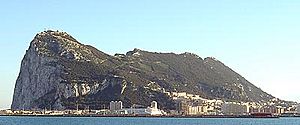
Ferdinand IV went to Córdoba. There, James II's messengers said he was ready to besiege Almería. In Córdoba, Ferdinand IV discussed the plan again. His brother Peter, John of Castile, and others did not want to besiege Algeciras. They preferred to raid Granada. But Ferdinand IV insisted. The Castilian troops prepared to besiege Algeciras. Supplies were sent by river and then by sea.
On July 27, 1309, part of the Castilian army arrived at Algeciras. Three days later, Ferdinand IV and John of Castile arrived. James II of Aragon began besieging Almería on August 15. A few days after starting the Algeciras siege, Ferdinand IV sent troops to besiege Gibraltar. Gibraltar surrendered to Castilian troops on September 12, 1309, after a short siege.
In mid-October 1309, John of Castile, his son, and Juan Manuel of Villena deserted. They left the Christian camp with 500 knights. This happened because Ferdinand IV owed them money. This angered European courts and James II of Aragon. But Ferdinand IV, with support from his brother Peter and others, continued the siege of Algeciras.
The Christian camp ran out of supplies. Ferdinand IV had to pawn his wife's jewels and crowns to pay soldiers. Later, more troops arrived. At the end of 1309, Diego López V de Haro became very ill. Alonso Pérez de Guzmán died. The camp was flooded by rain. And John of Castile and Juan Manuel of Villena had deserted. Despite this, Ferdinand IV tried to capture Algeciras. But in the end, he gave up.
In January 1310, Ferdinand IV decided to negotiate with Granada. An agreement was reached. In exchange for lifting the siege, Ferdinand would receive two cities and 50,000 gold coins. Ferdinand ordered the siege lifted. After the agreement, Diego López V de Haro died. His niece, María I Díaz de Haro, took possession of the Lordship of Biscay. John of Castile returned some towns to the King. At the same time, James II of Aragon lifted the siege of Almería.
Overall, the 1309 campaign was more successful for Castile than for Aragon. Ferdinand IV gained Gibraltar. The desertion of John of Castile and Juan Manuel of Villena was seen as a betrayal by other European courts.
Final Years and Death (1310–1312)
Conflicts with John of Castile and Juan Manuel of Villena (1310–1311)
In 1310, Ferdinand IV sent Juan Núñez II de Lara to talk with Pope Clement V. He asked the Pope not to allow a process against Pope Boniface VIII. Boniface VIII had legitimized Ferdinand's parents' marriage. Juan Núñez II de Lara also explained why the siege of Algeciras was lifted. He asked for money to continue the war against Granada. Pope Clement V tried to calm King Philip IV of France's anger towards Pope Boniface VIII. He condemned John of Castile and Juan Manuel of Villena's actions. He also gave Ferdinand IV money from church taxes for a year. He ordered church leaders to scold those who did not help Ferdinand IV.
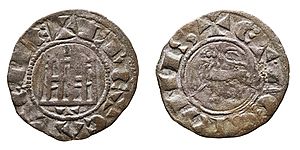
Meanwhile, Ferdinand IV restarted the war against Granada. His brother Peter captured a castle. In November 1310, both brothers went to Córdoba. There had been a popular uprising against some knights. Queen María de Molina asked her son to join her in Valladolid. She wanted him to be at his sister Isabella's wedding. On his way to Burgos, Ferdinand IV told Juan Núñez II de Lara that he planned to arrest or kill John of Castile. He believed John would always cause him trouble. But Juan Núñez II de Lara realized that if he helped, he would be next.
Ferdinand IV arrived in Burgos in January 1311. After his sister's wedding, he planned to kill John of Castile. This was revenge for John's desertion at Algeciras. It was also to control the rebellious nobles. But the Queen warned John of Castile, and he escaped. Ferdinand IV and his brother Peter chased John of Castile, who took refuge in Saldaña.
The King removed John of Castile's title. He ordered the seizure of lands he had given to John and his sons. Juan Manuel of Villena then reconciled with the King. He asked to be made First Majordomo. Ferdinand IV agreed, hoping to break Juan Manuel's friendship with John of Castile. He gave the position to Juan Manuel. His brother Peter received other cities as compensation.
In February 1311, Juan Manuel of Villena left Burgos and met John of Castile. John of Castile's supporters prepared to defend him. Ferdinand IV did not want a full revolt. He wanted to focus on the war against Granada. So, he sent his mother to negotiate with John of Castile and his supporters. The talks lasted fifteen days. The meeting ended with peace between John of Castile and Ferdinand IV. Queen Constance and Juan Núñez II de Lara opposed this peace. Soon after, Ferdinand IV met John of Castile and confirmed the agreement.
On March 20, 1311, Ferdinand IV confirmed new privileges for churches and their leaders. In April 1311, Ferdinand IV became seriously ill in Palencia. He was moved to Valladolid. His wife, Queen Constance, wanted him moved to Carrión de los Condes. She wanted to control him with her ally, Juan Núñez II de Lara. During Ferdinand's illness, disagreements arose among the nobles. In August 1311, the Queen gave birth to a son, the future Alfonso XI of Castile. The King wanted his mother to be the guardian of his son. But Queen Constance insisted that his brother Peter be the guardian.
In late 1311, a plot arose to overthrow Ferdinand IV. John of Castile, Juan Núñez II de Lara, and Lope Díaz de Haro were involved. But the Queen strongly refused to support it, and the plot failed.
Concord of Palencia and Calatayud Meeting (1311–1312)
In mid-1311, John of Castile and other nobles threatened to stop serving Ferdinand IV. They demanded that the King replace his advisors with themselves. Juan Manuel of Villena remained loyal to Ferdinand IV.
To achieve peace and continue the Reconquista, Ferdinand IV signed the Concord of Palencia on October 28, 1311. Its terms were confirmed in the 1312 Cortes of Valladolid. The King promised to respect the nobles' customs and privileges. He also agreed not to take back lands they had received from the Crown. Ferdinand IV confirmed that his son Alfonso's guardianship would go to his brother Peter. Peter also received the city of Santander. The King gave John of Castile the town of Ponferrada. But John broke his promise not to ally with Juan Núñez II de Lara eight days later.
In December 1311, Ferdinand IV met with James II of Aragon in Calatayud. Ferdinand's brother Peter married James II's daughter, Maria. Ferdinand also gave his eldest daughter, Eleanor, to James II. She would be raised in Aragon until she was old enough to marry James II's son.
At the Calatayud meeting, they also agreed to restart the war against Granada. But each kingdom would fight separately. James II promised to help mediate a conflict between Ferdinand IV and his father-in-law, Denis of Portugal. This was about some cities Denis had taken during Ferdinand's childhood. But Ferdinand's death in 1312 ended these talks. On April 3, 1312, Juan Manuel of Villena married another daughter of James II.
Last Period of Ferdinand IV's Life (1312)
After Calatayud, Ferdinand IV went to Valladolid for the Cortes. This was the last Cortes of his reign. Funds were raised for the next campaign against Granada. Justice, territorial, and local administration were reorganized. This showed the King's desire for deep reforms. He also wanted to strengthen royal power against the nobility. The Cortes approved taxes to pay soldiers.
In October 1311, Ferdinand IV asked King Edward II of England for a loan. He needed it for the war against Granada. But the English king refused, citing his own war with Scotland. In July 1312, Ferdinand IV pawned Templar castles to King Denis of Portugal for money. This was also for the war against Granada. In April 1312, after the Cortes, the King left Valladolid. In 1312, Ferdinand's cousin, Sancho of Castile, died without legitimate children. The King took his cousin's lands for the Crown. Ferdinand then went to Salamanca. He took back some towns from his cousin Alfonso de la Cerda, who had rebelled again.
On July 13, 1312, the King arrived in Toledo. He left his son, Alfonso, in Ávila. He then went to the province of Jaén. His brother Peter was besieging Alcaudete there. After a short stay in Jaén, the King went to Martos. There, he ordered the execution of the Carvajal brothers. They were accused of murdering his advisor. Legend says the Carvajal brothers predicted Ferdinand's death would come soon after their execution.
After Martos, the King went to Alcaudete. He waited for John of Castile to join the siege. But John of Castile did not appear. He feared Ferdinand IV would order his death. Ferdinand IV became very ill. He left the siege of Alcaudete and went to Jaén in late August 1312.
On September 5, 1312, the garrison of Alcaudete surrendered after three months. Peter went to Jaén to meet his brother. On September 7, the day Ferdinand IV died, both brothers agreed to help Nasr, Sultan of Granada. They had made a truce with him. They would help him fight his brother-in-law, who had rebelled.
Different Stories of the King's Death
Ferdinand IV died on September 7, 1312, in Jaén. No one saw him die. History and legend are mixed regarding his death. He was called "the Summoned" because of the mysterious way he died. Ferdinand IV was only 26 years old. He left behind a 1-year-old son, who would become King Alfonso XI of Castile.
The Chronicle of Fernando IV, written about 30 years after his death, says Ferdinand IV was found dead in his bed. "No one saw him die."
Historian Francisco Simón y Nieto suggested in 1912 that Ferdinand IV might have died from a heart attack or a stroke. Other possibilities include lung problems or a sudden fainting spell.
Burial
In September 1312, soon after his death, Ferdinand IV's body was taken to Córdoba. On September 13, he was buried in a chapel of the Mosque–Cathedral of Córdoba. He should have been buried in Toledo Cathedral or Seville Cathedral.
But because of the hot weather in September 1312, Queen Constance of Portugal, Ferdinand's widow, and his brother Peter decided to bury him in Córdoba. Queen Constance also set up six chaplaincies. She ordered a yearly memorial service for the King in September. For a year after his death, four candles burned at his grave. The bishop and church leaders prayed for his soul daily. In 1371, Ferdinand IV's remains and those of his son Alfonso XI were moved to the Royal Chapel of the Mosque–Cathedral of Córdoba.
In 1728, Pope Benedict XIII linked the Royal Chapel to the Church of Saint Hippolytus in Córdoba. That same year, the canons of Saint Hippolytus asked Philip V to move the kings' remains to their church. The King agreed.
Work on the Church of Saint Hippolytus finished in 1736. On the night of August 8, 1736, Ferdinand IV and Alfonso XI's remains were moved. They now rest in the Royal Collegiate Church of Saint Hippolytus. The church also received all the furniture from the Royal Chapel.
In the church, the tombs of Ferdinand IV and his son Alfonso XI are in the first section of the presbytery. They are in two special arched spaces. The kings' remains are in red marble urns. These urns were made in 1846.
Before that, the kings' remains were in wooden coffins. They were shown to important visitors. On top of the tombs are pillows with a crown and scepter. These are symbols of royalty.
Marriage and Children
Ferdinand IV married Constance, daughter of King Denis of Portugal, in Valladolid on January 23, 1302. They had three children:
- Eleanor (1307–1359): She first married James of Aragon in 1319, but that marriage was canceled. She then married King Alfonso IV of Aragon in 1329. She was killed in Castrojeriz by her nephew, King Peter of Castile.
- Constance (1308–1310): She died as a baby. Her remains are now in the crypt of the Church of San Antonio de los Alemanes.
- Alfonso XI (1311–1350): He became king after his father. He died from the Black Death during the Fifth Siege of Gibraltar.
See also
 In Spanish: Fernando IV de Castilla para niños
In Spanish: Fernando IV de Castilla para niños



